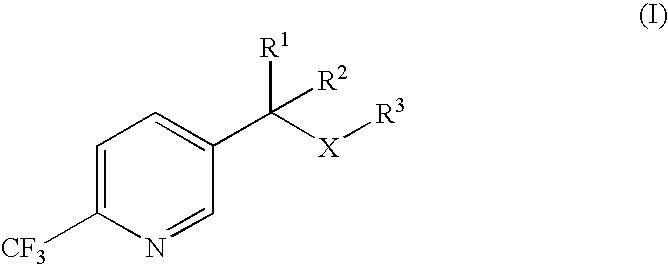Process for the preparation of 2-trifluoromethyl-5-(1-substituted)alkylpyridines
a technology of alkylpyridine and trifluoromethyl, which is applied in the field of process for the preparation of 2trifluoromethyl5(1-substituted) alkylpyridines, can solve the problems of relatively high cost and unstable stability of 4-alkoxy-1,1,1-trifluoro-3-buten-2-ones
- Summary
- Abstract
- Description
- Claims
- Application Information
AI Technical Summary
Benefits of technology
Problems solved by technology
Method used
Image
Examples
example 1
Preparation of 5-(1-methylthio)ethyl-2-(trifluoromethyl)pyridine
[0058]
Step 1. Preparation of 1-(3-methylthiobut-1-enyl)pyrrolidine
[0059]
[0060]To a dry 5000 milliliter (mL) round bottom flask equipped with mechanical stirrer, nitrogen inlet, addition funnel, and thermometer, was charged 591 g (4.27 moles) of dry granular potassium carbonate and 1428 mL (17.1 moles) of anhydrous pyrrolidine. The mixture was stirred under a atmosphere of nitrogen, and cooled to 4° C. with an ice bath, after which 1050 mL (8.9 moles) of 3-methyl-thiobutyraldehyde was added at a rate that maintains the temperature below 10° C. Upon the completion of the addition, the cooling bath was removed and the reaction was allowed to reach room temperature. The reaction contents were then filtered through a sintered glass filter funnel to remove the solids, and the solids were washed with 200 mL of anhydrous ethyl ether. The filtrate was concentrated under vacuum on a rotary evaporator until all of the pyrrolidine ...
example 2
Alternate preparation of 5-(1-methylthio)ethyl-2-(trifluoromethyl)pyridine
[0063]
[0064]To a 500 mL jacketed reactor equipped with a circulation bath (containing syltherm 800), mechanical stirring, dry-ice / acetone condenser, and a thermowell with digital monitoring was charged with 240 mL of toluene followed by 43.3 g (0.6 mol) of ethyl vinyl ether (EVE) in one portion. The reaction mixture was cooled to 0° C. and then a ¼″ Teflon line was placed sub-surface into the reaction mixture. Trifluoroacetyl chloride (TFAC) was bubbled through this Teflon line over a 1 h period until 95.3 g (0.72 mol) of trifluoroacetyl chloride reagent had been added. The internal reaction temperature rose from 2° C. to 6° C. over the TFAC addition. The circulation bath temperature was then set at 20° C. and the reaction mixture was allowed to warm up to the circulation bath set point and stirred for an additional 20 min. At this time, GC analysis indicated that EVE starting material was present in about 4% ...
example 3
Alternate preparation of 5-(1-methylthio)ethyl-2-(trifluoromethyl)pyridine
[0069]
[0070]To a 2-liter three-neck round bottom flask equipped with mechanical stirring, a nitrogen pad, and a temperature probe was charged with 152.0 g (1.10 mol) of solid potassium carbonate followed by ˜1 liter of toluene. To this mixture was added 71.1 g (1.00 mol) of pyrrolidine. The reaction mixture was cooled in an ice-water bath and then 118.20 g (1.00 mol) of 3-methylthiobutanal was continuously added via addition funnel over a 1 h 16 min period. Addition rate of aldehyde was adjusted so the internal reaction temperature was maintained below ˜10° C. The ice-water bath was removed and the reaction mixture was allowed to warm to ambient temperature and stirred an additional 3 h 30 min. At this time, GC analysis indicated that starting 3-methylthiobutanal was present in about ˜0.4% (relative area). The reaction mixture was suction filtered and the filter cake was rinsed with 250 mL of fresh toluene. Th...
PUM
 Login to View More
Login to View More Abstract
Description
Claims
Application Information
 Login to View More
Login to View More - R&D
- Intellectual Property
- Life Sciences
- Materials
- Tech Scout
- Unparalleled Data Quality
- Higher Quality Content
- 60% Fewer Hallucinations
Browse by: Latest US Patents, China's latest patents, Technical Efficacy Thesaurus, Application Domain, Technology Topic, Popular Technical Reports.
© 2025 PatSnap. All rights reserved.Legal|Privacy policy|Modern Slavery Act Transparency Statement|Sitemap|About US| Contact US: help@patsnap.com



